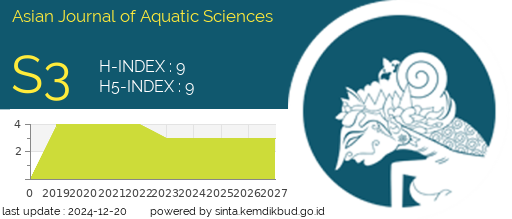STUDY OF GILL, KIDNEY, AND LIVER STRUCTURE OF Pangasius hypophthalmus IN THE TANJUNG KUDU LAKE AND SAIL RIVERS, RIAU PROVINCE
DOI:
https://doi.org/10.31258/Keywords:
Histological Structure, Histopathological Alteration Indeks, Tanjung Kudu Lake, Sail RiverAbstract
Environmental condition and water quality in general may affects the health status of fish and it represents in the structure of fish organs such as the gill, kidney, and liver. To understand the structure of the gill, kidney, and liver of Pangasius hypophthalmus that live in the Tanjung Kudu Lake (good water quality) and in the Sail River that has been polluted, a study has been conducted from November to December 2020. Twelve fishes (6 fishes/river) were analyzed. The tissue was formalin-fixed and processed through alcohol series, paraffin-embedded, 5m sliced and Hematoxylin-Eosin stained. The histological samples were then studied using a binocular microscope Olympus CX 21. The abnormality level of the tissue was categorized using the Histopathological Alteration Indeks (HAI). Results showed that the fish tissues from both study sites indicate light abnormality signs such as hyperplasia, hypertrophy, and lifted epithelia. The HAI was 2 for fish from the Tanjung Kudu Lake and 3 for the fish from the Sail River. This index indicates that the abnormality may be cured as the water quality improved.
Downloads
References
1. Windarti, A. H. Simarmata dan Eddiwan. (2017). Buku Ajar Histologi. UR Press. Pekanbaru.
2. Yanda, M. H. Syawal dan M. Riauwaty. (2018). Ectoparasites Distribution of Catfish (Pangasius hypophthalmus) in Fishpond Kuok Village, Bangkinang Barat District, Kampar Regency, Riau Province. Jurnal Online Mahasiswa Fakultas Perikanan dan Ilmu Kelautan, 5: 1-13.
3. Ismail, K. (2016). Kiat Mengatasi Stress pada Ikan. Penerbit Mediatama. Bogor.
4. Suhara, A. (2019) Teknik Budidaya Pembesaran Dan Pemilihan Bibit Ikan Patin (Studi Kasus di Lahan Luas Desa Mekar Mulya, Kec. Teluk Jambe Barat, Kab. Karawang). Jurnal Buana Pengabdian, 1(2): 1-8.
5. Pertiwi, S.L., Zainuddin dan E. Rahmi. (2017). Histological Respiratory System of Snakehead (Channa striata). Jurnal Ilmiah Mahasiswa Veteriner, 1(3):291-298
6. Hardi, E.H. (2015). Parasit Biota Akuatik. Mulawarman University Press. Samarinda
7. Rifqiyati, N., M.J. Luthfi. dan A.N. Miftah. (2017). Gambaran Histologi Insang Ikan Mas Koki (Carassius auratus) yang Terinfeksi Ektoparasit Argulus sp. Jurnal Bionature 18(1): 1-7
8. Susanah, U.A. (2013). Struktur Mikroanatomi Insang Ikan Bandeng di Tambak Wilayah Tapak Kelurahan Tugurejo Kecamatan Tugu Semarang. Journal of Biology & Biology Education, 5(1): 1-9.
9. Kahfi, K. E., M. Riauwaty., I. Lukistyowati. (2017). Histopathology Liver and Kidney of Clarias Gariepinus that are Fed Simplisia Mangosteen Rind (Garcinia Mangostana L). Jurnal Online Mahasiswa Fakultas Perikanan dan Ilmu Kealutan, 4(1): 1-10
10. Yolanda, S., Rosmaidar, Nazaruddin, T. Armansyah, U. Balqis, dan Y. Fahrima. (2017). The Effect of Lead (Pb) Exposure to the Histopathology of Nile Tilapia (Oreochromis nilloticus) Gill. Jurnal Ilmiah Mahasiswa Veteriner, 1(4):736-741
11. Juanda, S.J., dan S.I. Edo. (2018). Histopatologi Insang, Hati dan Usus Ikan Lele (Clarias gariepinus) di Kota Kupang, Nusa Tenggara Timur. Jurnal Saintek Perikanan, 14(1): 23-29.
12. Indrayani, D., Yusfiati, R. Elvyra. (2014). Struktur Insang Ikan Ompok hypophthalmus (Bleeker, 1846) dari Perairan Sungai Siak Kota Pekanbaru. JOM FMIPA, 1(2)
13. Lestari, W.P., N.I. Wiratmini, dan A.A.G.R. Dalem. (2018). Histological Structures of Gills of Tilapia Fish (Oreochromis mossambicus L.) as a Water Quality Indicator in the Nusa Dua Sewage Tretment Ponds, Bali. 6(2 ): 45− 49
14. Sipahutar, L. W., D. Aliza, Winaruddin, dan Nazaruddin. (2013). Histopathological Changes of Gills of Nile Tilapia (Oreochromis niloticus) Maintained in Above Normal Water Temperature. Jurnal Medika Veterinaria, 7(1):1920.
15. Camargo, M. M.P., and C.B.R. Martinez. (2007). Histopathology of Gills, Kidney and Liver of a Neotropical Fish Caged in an Urban Stream. Neotropical Ichthyology, 5(3):327-336
16. Lujić, J., Z. Marinović, dan B. Miljanović. (2013). Histological Analysis of Fish Gills as an Indicator of Water Pollution in the Tamiš River. Acta Agriculturae Serbica, 18(36): 3-141.
17. Mulyani, F.A.M. (2014). Uji Toksisitas dan Perubahan Struktur Mikroanatomi Insang Ikan Nila Larasati (Oreochromis nilloticus Var.) yang Dipapar Timbal Asetat. Universitas Negeri Semarang.
18. Movahedinia, A., B. Abtahi, and M. Bahmani. (2012). Gill Histopathological Lesions of the Sturgeons. Asian Journal of Animal and Veterinary Advances, 7: 710-717.
19. Soelistyoadi, R.N., A.D. Nurekawati, dan D. Setyawati. (2020). Morphology and Sequencing of Myxobolus koi DNA that Infects Koi fish (Cyprinus carpio) in Blitar Regency. Journal of Aquaculture Science, 5(1): 38-53.
20. Prihartini, N.C., dan Alfiyah. (2017). Myxosporeasis In Koi (Cyprinus carpio). Samakia: Jurnal Ilmu Perikanan, 8(1): 6-10.
21. Mc Gavin, M. D., dan J.F. Zachary. (2007). Pathologic Basic of Veterinary Disease. Mosby Incorporation, USA.
22. Laily, H., Farikhah, dan U. Firmani. (2018). Analisis Histologis Ginjal, Hati, dan Jantung Ikan Lele Afrika Clarias gariepinus yang Mengalami Anomali pada Sirip Pektoral. Jurnal Perikanan Pantura (JPP), 1(2): 30-38
23. Riauwaty, M. (2013). Histopatology of Liver and Kidney of Pangasius hypophthalmus Infected with Aeromonas hydrophila and are Cured using Curcuma xanthorrhiza Roxb Extract. Repository Unri.
24. Rahayu, N. I., Rosmaidar, M. Hanafiah, T. F. Karmil, T. Z. Helmi, dan R. Daud. (2017) Influence of Lead (Pb) Exposure on the Rate of Growth Tilapia Fish (Oreochromis niloticus). Jurnal Ilmiah Mahasiswa Veteriner, 1(4):658-665
25. García, A. M., A. Kun, O. Calero, M. Medina, and M. Calero. (2018). An Overview of the Role of Lipofuscin in Age-Related Neurodegeneration. Front. Neurosci, 12:464.
26. Vekshin, N.L., dan M.S. Frolova. (2018). Formation and Destruction of Thermo Lipofuscin in Mitochondria. Biochem Anal Biochem, 7: 357.
27. Ahmad, Z., dan Damayanti. (2018). Skin Aging: Pathophysiology and Clinical Manifestation. Periodical of Dermatology and Venereology, 30(3): 208-215







